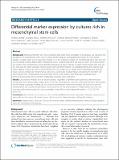| dc.contributor.author | Wetzig, Andrew | en_US |
| dc.contributor.author | Alaiya, Ayodele | en_US |
| dc.contributor.author | Al-Alwan, Monther | en_US |
| dc.contributor.author | Pradez, Christian Benedict | en_US |
| dc.contributor.author | Pulicat, Manogaran S | en_US |
| dc.contributor.author | Al-Mazrou, Amer | en_US |
| dc.contributor.author | Shinwari, Zakia | en_US |
| dc.contributor.author | Sleiman, Ghida Majed | en_US |
| dc.contributor.author | Ghebeh, Hazem | en_US |
| dc.contributor.author | Al-Humaidan, Hind | en_US |
| dc.contributor.author | Gaafar, Ameera | en_US |
| dc.contributor.author | Kanaan, Imaduddin | en_US |
| dc.contributor.author | Adra, Chaker | en_US |
| dc.date.accessioned | 2014-12-02T21:28:48Z | |
| dc.date.issued | 2013 | en_US |
| dc.identifier.citation | Wetzig, A., A. Alaiya, M. Al-Alwan, C. B. Pradez, M. S. Pulicat, A. Al-Mazrou, Z. Shinwari, et al. 2013. “Differential marker expression by cultures rich in mesenchymal stem cells.” BMC Cell Biology 14 (1): 54. doi:10.1186/1471-2121-14-54. http://dx.doi.org/10.1186/1471-2121-14-54. | en |
| dc.identifier.issn | 1471-2121 | en |
| dc.identifier.uri | http://nrs.harvard.edu/urn-3:HUL.InstRepos:13454782 | |
| dc.description.abstract | Background: Mesenchymal stem cells have properties that make them amenable to therapeutic use. However, the acceptance of mesenchymal stem cells in clinical practice requires standardized techniques for their specific isolation. To date, there are no conclusive marker (s) for the exclusive isolation of mesenchymal stem cells. Our aim was to identify markers differentially expressed between mesenchymal stem cell and non-stem cell mesenchymal cell cultures. We compared and contrasted the phenotype of tissue cultures in which mesenchymal stem cells are rich and rare. By initially assessing mesenchymal stem cell differentiation, we established that bone marrow and breast adipose cultures are rich in mesenchymal stem cells while, in our hands, foreskin fibroblast and olfactory tissue cultures contain rare mesenchymal stem cells. In particular, olfactory tissue cells represent non-stem cell mesenchymal cells. Subsequently, the phenotype of the tissue cultures were thoroughly assessed using immuno-fluorescence, flow-cytometry, proteomics, antibody arrays and qPCR. Results: Our analysis revealed that all tissue cultures, regardless of differentiation potential, demonstrated remarkably similar phenotypes. Importantly, it was also observed that common mesenchymal stem cell markers, and fibroblast-associated markers, do not discriminate between mesenchymal stem cell and non-stem cell mesenchymal cell cultures. Examination and comparison of the phenotypes of mesenchymal stem cell and non-stem cell mesenchymal cell cultures revealed three differentially expressed markers – CD24, CD108 and CD40. Conclusion: We indicate the importance of establishing differential marker expression between mesenchymal stem cells and non-stem cell mesenchymal cells in order to determine stem cell specific markers. | en |
| dc.language.iso | en_US | en |
| dc.publisher | BioMed Central | en |
| dc.relation.isversionof | doi:10.1186/1471-2121-14-54 | en |
| dc.relation.hasversion | http://www.ncbi.nlm.nih.gov/pmc/articles/PMC4235221/pdf/ | en |
| dash.license | LAA | en_US |
| dc.subject | Mesenchymal stem cell | en |
| dc.subject | Cell surface markers | en |
| dc.subject | Bone marrow mesenchymal stem cell | en |
| dc.subject | Breast adipose stem cell | en |
| dc.subject | Fibroblasts and olfactory | en |
| dc.title | Differential marker expression by cultures rich in mesenchymal stem cells | en |
| dc.type | Journal Article | en_US |
| dc.description.version | Version of Record | en |
| dc.relation.journal | BMC Cell Biology | en |
| dc.date.available | 2014-12-02T21:28:48Z | |
| dc.identifier.doi | 10.1186/1471-2121-14-54 | * |
| dash.authorsordered | false | |


